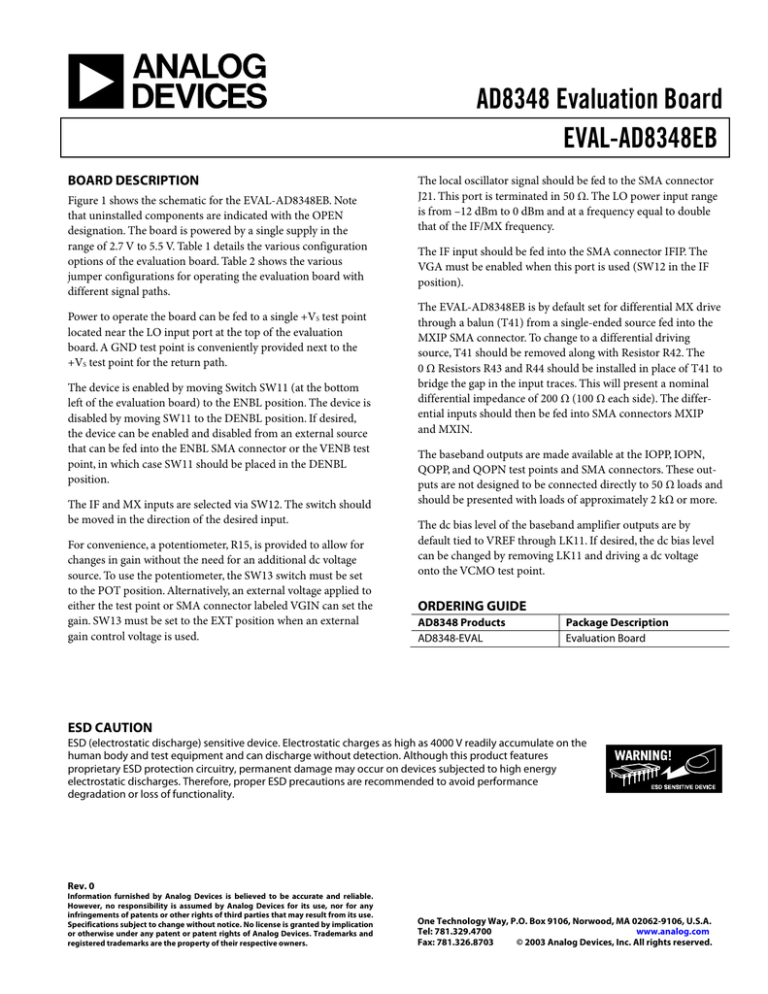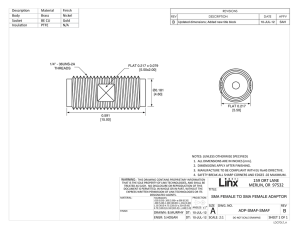
AD8348 Evaluation Board
EVAL-AD8348EB
BOARD DESCRIPTION
Figure 1 shows the schematic for the EVAL-AD8348EB. Note
that uninstalled components are indicated with the OPEN
designation. The board is powered by a single supply in the
range of 2.7 V to 5.5 V. Table 1 details the various configuration
options of the evaluation board. Table 2 shows the various
jumper configurations for operating the evaluation board with
different signal paths.
Power to operate the board can be fed to a single +VS test point
located near the LO input port at the top of the evaluation
board. A GND test point is conveniently provided next to the
+VS test point for the return path.
The device is enabled by moving Switch SW11 (at the bottom
left of the evaluation board) to the ENBL position. The device is
disabled by moving SW11 to the DENBL position. If desired,
the device can be enabled and disabled from an external source
that can be fed into the ENBL SMA connector or the VENB test
point, in which case SW11 should be placed in the DENBL
position.
The IF and MX inputs are selected via SW12. The switch should
be moved in the direction of the desired input.
For convenience, a potentiometer, R15, is provided to allow for
changes in gain without the need for an additional dc voltage
source. To use the potentiometer, the SW13 switch must be set
to the POT position. Alternatively, an external voltage applied to
either the test point or SMA connector labeled VGIN can set the
gain. SW13 must be set to the EXT position when an external
gain control voltage is used.
The local oscillator signal should be fed to the SMA connector
J21. This port is terminated in 50 Ω. The LO power input range
is from –12 dBm to 0 dBm and at a frequency equal to double
that of the IF/MX frequency.
The IF input should be fed into the SMA connector IFIP. The
VGA must be enabled when this port is used (SW12 in the IF
position).
The EVAL-AD8348EB is by default set for differential MX drive
through a balun (T41) from a single-ended source fed into the
MXIP SMA connector. To change to a differential driving
source, T41 should be removed along with Resistor R42. The
0 Ω Resistors R43 and R44 should be installed in place of T41 to
bridge the gap in the input traces. This will present a nominal
differential impedance of 200 Ω (100 Ω each side). The differential inputs should then be fed into SMA connectors MXIP
and MXIN.
The baseband outputs are made available at the IOPP, IOPN,
QOPP, and QOPN test points and SMA connectors. These outputs are not designed to be connected directly to 50 Ω loads and
should be presented with loads of approximately 2 kΩ or more.
The dc bias level of the baseband amplifier outputs are by
default tied to VREF through LK11. If desired, the dc bias level
can be changed by removing LK11 and driving a dc voltage
onto the VCMO test point.
ORDERING GUIDE
AD8348 Products
AD8348-EVAL
Package Description
Evaluation Board
ESD CAUTION
ESD (electrostatic discharge) sensitive device. Electrostatic charges as high as 4000 V readily accumulate on the
human body and test equipment and can discharge without detection. Although this product features
proprietary ESD protection circuitry, permanent damage may occur on devices subjected to high energy
electrostatic discharges. Therefore, proper ESD precautions are recommended to avoid performance
degradation or loss of functionality.
Rev. 0
Information furnished by Analog Devices is believed to be accurate and reliable.
However, no responsibility is assumed by Analog Devices for its use, nor for any
infringements of patents or other rights of third parties that may result from its use.
Specifications subject to change without notice. No license is granted by implication
or otherwise under any patent or patent rights of Analog Devices. Trademarks and
registered trademarks are the property of their respective owners.
One Technology Way, P.O. Box 9106, Norwood, MA 02062-9106, U.S.A.
Tel: 781.329.4700
www.analog.com
Fax: 781.326.8703
© 2003 Analog Devices, Inc. All rights reserved.
EVAL-AD8348EB
J21
LO
+VS
C52
0.1µF
4 5
C51
100pF
IOPN
J3I
IOPN
GND
T21
ETC1-1-13
QOPN
3 1
GND
C9I
OPEN
R5I
0Ω
IOPP
C8I
OPEN
R4I
0Ω
C21
1000pF
R21
60.4Ω
C22
1000pF
R5Q
0Ω
C9Q
OPEN
GND
R4Q
0Ω
C8Q
OPEN
QOPP
J3Q
QOPN
AD8348
J2I
IOPP
1 LOIP
LOIN 28
J2Q
QOPP
2 VPOS1 COM1 27
3 IOPN
C10I
0Ω
LK2I
R2I
OPEN
C7I
OPEN
C13
0.1µF
LK4I
IMXO
L3I
OPEN
L2I
OPEN
L1I
OPEN
LK3I
C3I
OPEN
C2I
OPEN
C1I
OPEN
LK1I
C6I
OPEN
C5I
OPEN
C4I
OPEN
4 IOPP
QOPP 25
5 VCMO
ENVG 24
LK4Q
6 IAIN
R1I
OPEN
COM3 22
8 IMXO
QMXO 21
R31
R32
57.6Ω 174Ω
C31
1000pF
C53
100pF
LK5I
MXIP 18
12 VPOS2
VGIN 17
13 IOFS
QOFS 16
14 VREF
ENBL 15
QMXO
L1Q
OPEN
L2Q
OPEN
L3Q
OPEN
LK1Q
C1Q
OPEN
C2Q
OPEN
C3Q
OPEN
R1Q
OPEN
C4Q
OPEN
C55
100pF
MXIN 19
11 IFIP
C5Q
OPEN
C56
0.1µF
VREF
ENBL
DENBL
IOFS
LK2Q
C7Q
OPEN
R2Q
OPEN
VCMO
+VS
R44
OPEN
R42
C43
1000pF 0Ω
MXIN
T41
ETK4-2T
R43
OPEN
LK5Q
C11
4.7µF
C12
0.1µF
POT
QOFS
C0I
0.1µF
Figure 1. Evaluation Board Schematic
Rev. 0 | Page 2 of 8
C0Q
0.1µF
C42
R41
1000pF OPEN
R14
10kΩ
SW13
R11
49.9Ω
J1Q
QMXO
C10Q
0Ω
MXIP
VENB
SW11
C6Q
OPEN
C41
1µF
+VS
R12
10kΩ
ENBL
VCMO
LK3Q
9 COM2 VPOS3 20
C32
1000pF
C54
0.1µF
QAIN 23
7 COM3
10 IFIN
+VS
R3Q
49.9Ω
LK11
VCMO
IFIP
MX
SW12
R3I
49.9Ω
J1I
IMXO
IF
EXT
R13
OPEN
R15
10kΩ
POT
VGIN
04468-0-059
VCMO
+VS
QOPN 26
04468-0-060
EVAL-AD8348EB
Figure 2. Evaluation Board Top Layer
Rev. 0 | Page 3 of 8
04468-0-061
EVAL-AD8348EB
Figure 3. Evaluation Board Top Silkscreen
Rev. 0 | Page 4 of 8
04468-0-062
EVAL-AD8348EB
Figure 4. Evaluation Board Bottom Layer
Rev. 0 | Page 5 of 8
04468-0-063
EVAL-AD8348EB
Figure 5. Evaluation Board Bottom Silkscreen
Rev. 0 | Page 6 of 8
EVAL-AD8348EB
Table 1. Evaluation Board Configuration Options
Component
+VS, GND
SW11, ENBL
SW13, R15,
VGIN
SW12
IFIP, R31, R32
MXIP, MXIN
T41,
R41, R42,
C42, C43
LK11, VCMO
C8, C9, R4, R5
(I and Q)
C10 (I and Q)
C1–C7
R1, R2
L1–L3
(I and Q)
LK5 (I and Q)
Function
Power Supply and Ground Vector Pins.
Device Enable. Place SW11 in the ENBL position to connect the ENBL pin to +VS. Place SW11 in
the DENBL position to disable the device by grounding the ENBL pin through a 50 Ω pull-down
resistor. The device may also be enabled via an external voltage applied to ENBL or VENB.
Gain Control Selection. With SW13 in the POT position, the gain of the VGA can be set using the
R15 potentiometer. With SW13 in the EXT position, the VGA gain can be set by an external
voltage to the SMA connector VGIN. For VGA operation, the VGA must first be enabled by
setting SW12 to the IF position.
VGA Enable Selection. With SW12 in the IF position, the ENVG pin is connected to +VS and the
VGA is enabled. The IF input should be used when SW12 is in the IF position. With SW12 in the
MX position, the ENVG pin is grounded and the VGA is disabled. The MX inputs should be used
when SW12 is in the MX position.
IF Input: The single-ended IF signal should be connected to this SMA connector. R31 and R32
form an L Pad that presents a 50 Ω termination to the input.
Mixer Inputs. These inputs can be configured for either differential or single-ended operation.
The evaluation board is by default set for differential MX drive through a balun (T41) from a
single-ended source fed into the MXIP SMA connector. To change to a differential driving
source, T41 should be removed along with Resistor R42. The 0 Ω Resistors R43 and R44 should
be installed in place of T41 to bridge the gap in the input traces. This will present a nominal
differential impedance of 200 Ω (100 Ω each side). The differential inputs should then be fed
into SMA connectors MXIP and MXIN.
Baseband Amplifier Output Bias. Installing LK11 connects VREF to VCMO. This sets the bias level
on the baseband amplifiers to VREF, which is equal to approximately 1 V. Alternatively, with
LK11 removed, the bias level of the baseband amplifiers can be set by applying an external
voltage to the VCMO test point.
Baseband Amplifier Outputs and Output Filter. Additional low-pass filtering can be provided at
the baseband output with these filters.
Mixer Output DC Blocking Capacitors. The mixer outputs are biased to VCMO. To prevent
damage to test equipment that cannot tolerate dc biases, C10 is provided to block the dc
component, thus protecting the test equipment.
Baseband Filter. These components are provided for baseband filtering between the mixer
outputs and the baseband amplifier inputs. The baseband amplifier input impedance is high
and the filter termination impedance is set by R2. See Table 2 for the jumper settings.
Table 2. Filter Jumper Configuration Options
LK1x
LK2x
LK3x
•
•
•
•
•
Rev. 0 | Page 7 of 8
•
SW2 = POT
SW12 = IF
R31 = 57.6 Ω
R32 = 174 Ω
T41 = M/A-COM ETK4-2T
R41, C42, C43 = OPEN
R42 = 0 Ω
LK11 Installed
R4, R5 = 0 Ω
C10 = 0 Ω
All = OPEN
LK5x = OPEN
Offset Compensation Loop Disable. Installing these jumpers will disable the offset
compensation loop for the corresponding channel.
Condition
xMXO to xAIN Direct
xMXO to xAIN via Filter
xMXO to J1x Direct, xAIN Unused
xMXO to J1x via Filter, xAIN Unused
Drive xAIN from J1x
Default Condition
Not Applicable
SW11 = ENBL
LK4x
•
•
•
EVAL-AD8348EB
NOTES
© 2003 Analog Devices, Inc. All rights reserved. Trademarks and
registered trademarks are the property of their respective owners.
C04468–0–9/03(0)
Rev. 0 | Page 8 of 8





